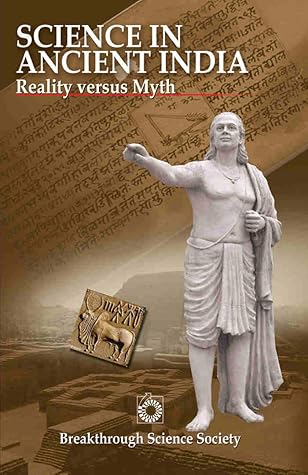Kindle Notes & Highlights
Read between
June 21 - July 7, 2022
Vedic period, and so we have to depend on the literature dating from the Vedic times. The end of the Vedic period is identified with the advent of the Jain and Buddhist religions and much of India adopting these religions. The post Vedic period is a time of remarkable advancements in science and mathematics as evidenced by the writings of legendary figures like Aryabhata, Brahmagupta, Bhaskara II
But they again needed a new symbol for 20. That way, they needed new symbols for 10, 20, 30, 100, 1000, etc. We see the same system of writing numbers all the way to Ashoka's time - the Brahmi and Kharosti scripts of the stone tablets also use the same method of writing numbers.
Rudimentary concepts of geometry can be found in Satapatha Brahmana and Taittiriya Samhita (900BC).
But the most impressive development in geometry can be found in the Shulvasutras.
The method of drawing a perpendicular bisector using a rope. Take two points A and B on a line, and take a rope longer than the distance between the two points. Mark the mid-point M of the rope by folding it in half. Now hold the two ends of the rope at the two points on the line, and stretch it in one direction. Mark the point C where the mid-point lies. Now stretch the rope in the other side and do the same thing. You get two points C and D, and the line joining them is the perpendicular bisector.
The six ritus, in the Vedic nomenclature, are Vasantaritu, Grishmaritu, Varsharitu, Sarathritu, Hemantaritu and Sisiraritu.
It is important to note that in the Vedic period there was no astrology - in the sense of beliefs in human lives being predestined by the time of birth and the influence of planets on human lives. The word Jyotisha was used in the sense of astronomy.
It is only towards the end of the Vedas (i.e., Vedanta), when we see spiritual content entering the cultural landscape.
But the later Vedas laid too much emphasis on ritualistic practices like yagnas, homas, chants, and on prescribing what to do and what not to do. Such an environment hampered the natural enquiring mind of men, and so the scientific enquiries subsided. With the "end" of Vedas when Vedanta came, it sought to create an alienation of the individual from the material world. Seeking nirvana away from life and society became the ideal for the learned people. This created a condition detrimental to the growth of scientific enquiry.
The idea of an "Aryan race" was originated by the German fascists, which has been debunked long since. Scientifically it is a language group, and those who spoke that group of languages are called Aryans.
Discovery of zero happened much after the Vedic age, in the Buddhist period.
The medicinal treatise Charaka Samhita discussed 150 types of diseases with further subdivisions, 341 medicinal plants, 177 medicinal substances of animal origin, and 64 medicinal substances of mineral origin. He also further categorized 102 types of pathological conditions and congenital defects, 109 anatomic and 42 physiological terms and 33 varieties of bones.
However, in the writings of Susruta and Charaka there is no description or instruction on how to place the head of an elephant on a human torso!


